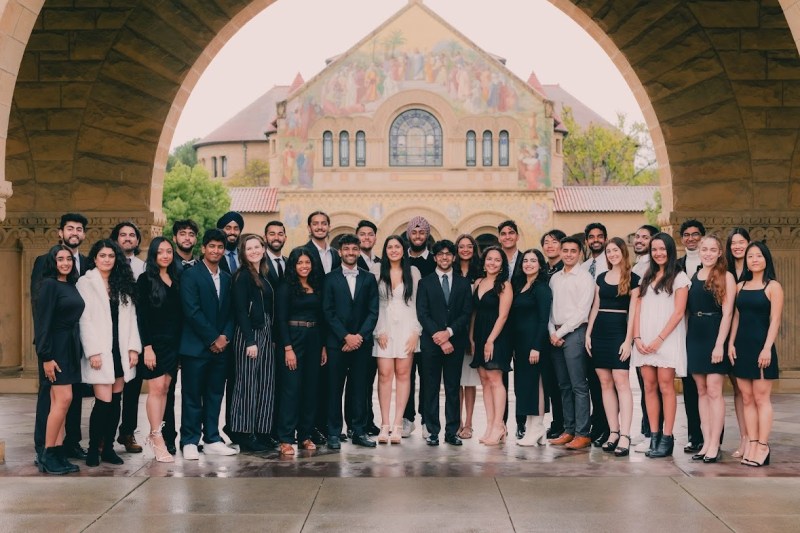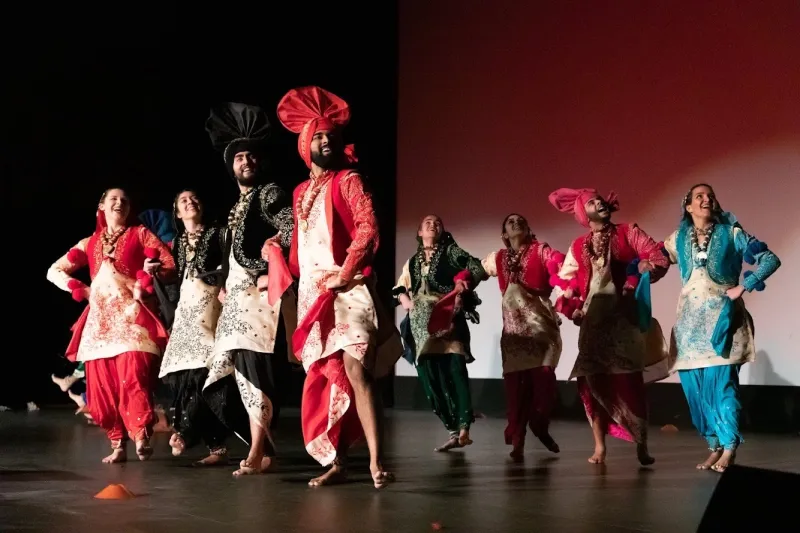Three times a week during the school year, desi energy overtakes campus as Stanford Bhangra practices for its upcoming competitions. In vibrant kurtas and turbans, with necklaces sparkling and phuman pom-poms waving, students perform graceful choreography to the rousing dhol drum beat and lively melodies of Punjabi music.
The student dance organization has weathered the pandemic — with veterans proudly bearing the name ZoomBs — and continues to compete nationally, in addition to performances on and around campus, as they have since their inception in 1996.
The dance form traces its origins to a much earlier time, originating in the Punjab region of modern-day India and Pakistan as a way for farmers to celebrate during the festival of Vaisakhi during the late 1800s. The holiday marks the start of the harvest season and the Sikh New Year.
“Since then, Bhangra [has] changed and spread a lot. There’s a Bhangra diaspora in the U.S., Canada, the U.K., India and Australia,” said Josh Singh ’24, a team captain for the past two school years.
Singh explained that every member of the group, or “Bhangra Tree,” is expected to stay educated on current events in Punjab and their repercussions around the world. Often, the group has discussions about how best to show respect to those who created the dance form, including during the Punjab farmers’ protests in New Delhi in 2022.
“For non-South Asian members, it’s a really good opportunity to learn,” Rebecca Spencer ‘24, a captain for the 2022-23 school year, said. “I feel so lucky that I’m surrounded by a community where everyone’s willing to learn and wants to teach at the same time. We don’t detach dance from culture. We’re trying to teach little bits of Punjabi to all the people on the team, encourage people to take Punjabi language classes or go to the Gurdwara when they have time.”
Cultural education is just one element that bonds members of Stanford Bhangra together. At its core, the group is a competitive dance team, and the opportunity to compete in national competitions provides a major source of bonding and enjoyment.
The season kicks off during winter quarter when prospective Bhangra Trees prepare their audition videos of the choreography chosen by Bhangra’s creative directors and captains. Winter is also when the team truly grows close, both in and out of practice. Every quarter, team members attend a retreat off-campus where new and returning members mingle.

During lengthy practices, the team becomes like “siblings,” as Singh described it.
“These are people you dance with, sweat with, bleed with and are bonded to,” Spencer added.
The team then launches into practice for the competitions at which it have been selected to perform. Stanford Bhangra participates in up to three competitions in a year.
“Some competitions want longer sets or shorter sets, and others give extra points for gimmicks or props,” said Ankush Dhawan ‘24, a Bhangra captain.
Many teams hire dhol drum players from outside Stanford to enhance their performances or use props like kainchiyaan (white wooden accordion-like percussion instruments) or phulkari and khundi sticks. The most important part, though, is still the dance. Dancing even simple Bhangra sets can be physically taxing because of the variety of footwork and jumps.
The majority of Stanford Bhangra members have never danced Bhangra — or danced at all — before college. They are often brought in by friends or siblings or simply after seeing students perform during admit weekend.
This usually happens on the club’s “bring your friend to Bhangra” days. According to Spencer, over 80 people came to the last open Bhangra practice.
Nathan Hu ’24, a captain, said his favorite part of the Stanford Bhangra experience was performing and being a part of the community.
“It’s so cool to be a part of the finished product,” he said. “We feel so connected. Dancing is less about our place in the competition and more about being able to watch the video afterward and think, ‘Damn, we did that.’”
The art form continues to expand its presence at Stanford as the group adds members each year, beyond its current 30 who make up their community. “The core of Stanford is community, and Bhangra is community — it’s family,” said Spencer.
